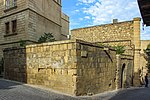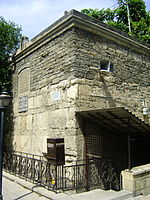Azerbaijan State Academic Philharmonic Hall
1912 establishments in the Russian EmpireBuildings and structures completed in 1912Buildings and structures in BakuConcert halls in AzerbaijanCulture in Baku ... and 2 more
Music venues in AzerbaijanTourist attractions in Baku

The Muslim Magomayev Azerbaijan State Academic Philharmonic Hall (Azerbaijani: Müslüm Maqomayev adına Azərbaycan Dövlət Akademik Filarmoniyası), located in Baku, is the main concert hall in Azerbaijan built in 1910. Since 2006 Murad Adigozalzade is the director of the Azerbaijan State Academic Philharmonic Hall.
Excerpt from the Wikipedia article Azerbaijan State Academic Philharmonic Hall (License: CC BY-SA 3.0, Authors, Images).Azerbaijan State Academic Philharmonic Hall
Aziz Aliyev street, Baku City
Geographical coordinates (GPS) Address Nearby Places Show on map
Geographical coordinates (GPS)
| Latitude | Longitude |
|---|---|
| N 40.3664 ° | E 49.835 ° |
Address
İçəri şəhər
Aziz Aliyev street
1095 Baku City (Sabail Raion)
Baku, Azerbaijan
Open on Google Maps











